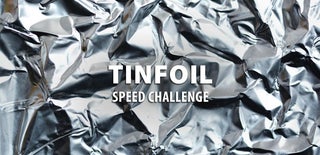Introduction: Clean Silver Jewelry With Tinfoli and Salt
Aluminium foil (tinfoil) can be used to clean silver in a quick and easy way, with no mess, no polishing solutions, no special cloths. This method works with silver, sterling silver and silver plated objects. Can be used with precious and semi-precious gems. I do not recommend this method for cleaning antique items.
Note: I’m not a chemist, so I’m going to explain it in layman’s terms.
That dark, dull film on silver called tarnish is caused by silver sulfide. Silver sulfide is a result of a chemical rection between silver and sulfur (either sulfur in the air or from direct contact). To restore silver to its original shiny colour you have to remove tarnish by either stripping it from the surface using silver polish or reverse the chemical reaction and turn silver sulfide into silver once again. This last method works best with jewelry, since some pieces are too small or difficult to reach with polish and cloth.
Step 1: How It's Done
Line a flat bottom container with foil. In a separate container mix 1 cup boiling water and 1 tablespoon table salt. Pour salt water into aluminium lined dish and place your jewelry inside. Use wooden or plastic tongs, chopsticks, or skewers to move the pieces around to make sure each piece touches the foil. All pieces have to be fully submerged, increase the amount of water if necessary.
Once chemical reaction begins you will see small bubbles forming around your items (last picture) and you will be able to detect faint rotten egg smell (sulfur).
Step 2: Cleaning
It might take between 1-20 min to remove all tarnish; in most cases it won’t take longer than 5 min for jewelry.
Take your item out after 5 minutes, rinse it, use paper towel to remove the residue. If your item is still tarnished, place it back into the salt bath. Use a small, stiff brush, cotton buds, toothpicks to remove tarnish residue from tight and difficult to get spaces. Finally, use microfibre cloth to buff your jewelry.
Step 3: Salt or Baking Soda?
This method is pretty well known, so you might have seen it online and noticed that there are a few different variations of this project.
Some recommend using baking soda instead of salt, some recommend both salt and baking soda, some go as far as mixing salt, soda and vinegar. I tried all of those methods with the same piece of silver and all those solutions worked the same.
I’m using salt, for two reasons: one- pretty much every household has salt, not everyone has baking soda in their kitchen; two- salt dissolves better than baking soda. With just baking soda I ended up having a thin coating of undissolved soda at the bottom of aluminium foil and I had to move my items around to find an exposed part of the foil.
Step 4: How Does It Work?
When silver sulfide (tarnish) comes in touch with aluminum (tinfoil), sulfur atoms are transferred from silver to aluminum forming aluminum sulfide.
3 Ag2S + 2 Al → 6 Ag + Al2S3
silver sulfide + aluminum → silver + aluminum sulfide
Aluminum sulfide then hydrolyzes to form aluminum hydroxide, Al(OH)3 and hydrogen sulfide, H2S. You will be able to tell when that reaction occurs as hydrogen sulfide has a distinctive, rotten egg odour. The more tarnished your jewelry, the more obnoxious the smell will be. You have been warned 😉
Al2S3 + 6H2O → 2Al(OH)3 + 3H2S
We add salt or baking soda for two reasons:
1) tinfoil has a thin film of aluminum hydroxide that has to be removed to expose aluminium underneath; salt and baking soda remove that film
2) both salt and baking soda are electrolytes, they improve the ease with which the electrons move between the silver and aluminum.
We use boiling water to speed the reaction, cold water would work too, but it would take more time.
Step 5: Results
Step 6: Results
Step 7: Results
Step 8: Bonus: How to TARNISH Silver on Purpose
Tarnish is not all bad, some jewelry pieces actually look better with a small amount of it. Tarnish in small crevices and dips makes details pop more, thus creating better looking jewelry.
Unless you have access to pure sulfur, your next best option are eggs.
Simply cook an egg for 15-20 min. Don’t cool it. Peel it, mash it and put it on a plate. Place your silver item on the same plate and cover the whole plate with cling film (tightly). You will be able to see oxidization within 5 minutes. The longer you leave it, the darker the silver will become, so check on it periodically to see if it’s dark enough for your needs.
The egg has to be hard-boiled, overcooked and preferably still hot. Doesn't matter if you use a whole egg, just yolk or just egg white; yolk and egg white contain similar amount of sulfur, egg white having a little bit more. It will work either way, it might take a little longer though.

Participated in the
Tinfoil Speed Challenge













